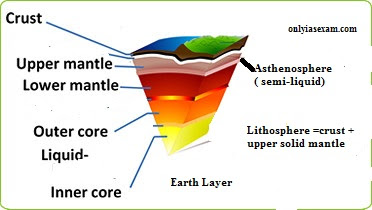Why the interior of the earth needs to study?
- To know the cause of natural phenomena such as earthquakes, volcanoes, and tsunamis.
- To understand the endogenic forces
- To understand the earth's magnetism.
- To understand plate tectonic movement.
Sources of information about the earth's interior
Direct sources:- Volcanic eruption
- Deep mining.
- Deep ocean drilling
- Surface rock study
- Seismic wave study of earthquake
- Geomagnetism study
- Study of meteorite
- Gravitational forces.
Gravitational Forces:
It is not the same at different latitudes on the surface. It is greater near the poles and less at the equator because the distance from the center at the equator is greater than at the poles. It gives information about the bulging of the earth at the equator.
Seismic wave study of earthquake:
Two types of earthquakes wave:
- Body wave
- Surface wave.
The body wave interacts with surface rock and generates a new type of wave, called surface rock.
Body wave:
The energy generated at focus, it moves all the direction of the body of the earth.There are two types of Body waves:
- P wave or primary wave
- S wave or secondary wave
P wave:
The faster and first-to-arrive surface is called the primary wave.
The faster and first-to-arrive surface is called the primary wave.
S wave:
It causes the collapse of the earth's surface. It can travel only through solid material. It helps to understand the interior of the earth's surface.
It causes the collapse of the earth's surface. It can travel only through solid material. It helps to understand the interior of the earth's surface.
Propagation of earthquake wave:
- P wave vibrates parallel to the direction of the wave. As a result, it creates a density difference in the material leading to stretching and squeezing of the materials. The p wave is the same as a sound wave; it travels in all mediums but the speed of the wave depends on the elasticity of the medium. High wave speed in less elastic materials. Wave speed is highest in solid, medium in liquid, and lowest in gas medium.
- S wave and other wave vibrates perpendicular to wave direction, hence it creates troughs and crests in the material. S waves can not travel in the liquid and gaseous medium.
The emergence of the shadow zone:
- In some specific areas where waves are not reported, such a zone is called the Shadow zone.
- S wave does not travel in a liquid medium. The entire zone beyond 105 degrees does not receive s wave, which means the outer core is made up of liquid.
- P waves are deflected when they pass from the solid mantle to the liquid outer core.
- The speed of the p wave decrease in the outer core and the speed increase in the inner core, which means the outer core is made up of liquid and the inner core is made up of a solid part.
- Due to the defection of waves in the outer core, the shadow zone of the p wave can be seen between 105 degrees to 145 degrees from the epicenter.
Interior of the earth;
 |
| Interior of the earth |
Broadly three layers of the earth are classified by the above source information:
- The Crust: from 0 to 100 km
- The Mantle: from 100 to 2900 km
- The Core: 2900 to 6400 km
The crust:
The following are the characteristics of the crust:- It is the upper part of the earth in solid form.
- By volume, it is only less than 1% of the earth.
- Below the ocean, it is appropriate to 50km depths and below Everest, it is about 100 km of depth.
- Mineral composition of the crust: Sial= silica + alumina.
- Made lightweight of granite rock
The mantle:
The following are the part of the mantle: - Upper mantle in solid form
- Asthenosphere in a semi-liquid form: It is the main source of magma in a volcanic eruption
- Lower layer in solid form
- The mineral composition of the mantle is: Sima = silica + magnesium
What is Lithosphere?
It ranges from 10 to 200 km)= crust + upper solid mantle.
The core:
There are two-part to the core:- Outer core: 2900 to 5100. It is in liquid form, and it is the source of earth's magnetism.
- The inner core: it is in solid form extending from 5100 to 6400 km.
- The composition of the core is: NiFe= nickel and ferrous
Some important characteristics of the earth's interior:
- Decreasing order of density : Core(5.9/g/cm3) ,Mantle(3.49 g/cm3) , Crust (2.7 g/cm3)
- Percentage-wise decreasing order minerals(in all layers of earth): iron (highest in the earth); oxygen, silicon, magnesium
- Percentage-wise mineral composition of the crust: oxygen (highest in the crust), silicon, aluminum, iron
You may like also:
ConversionConversion EmoticonEmoticon